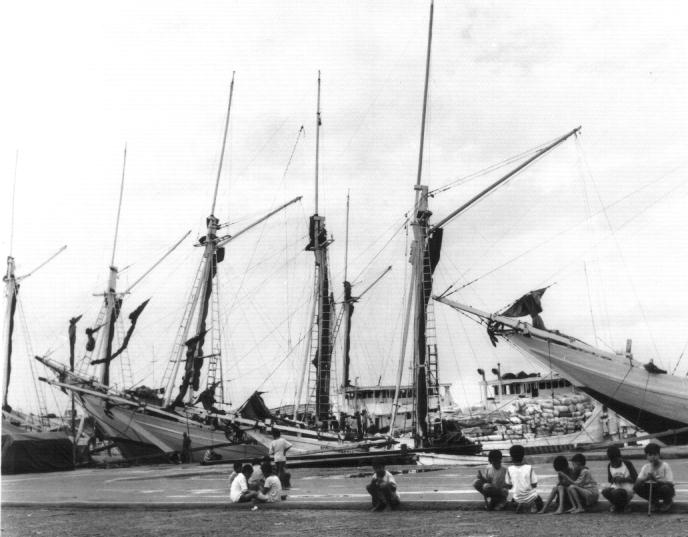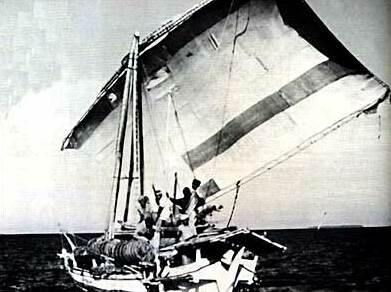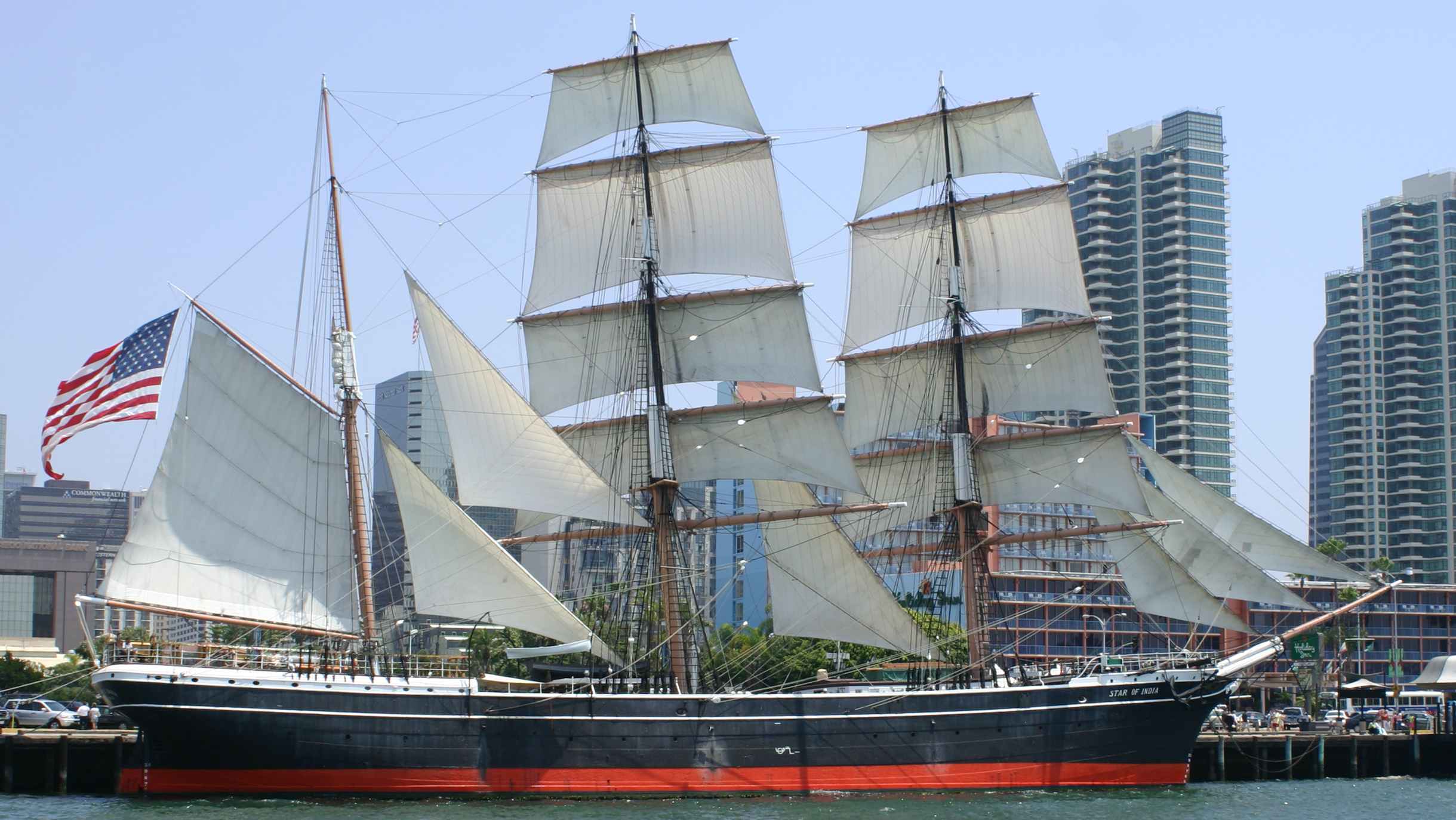|
Padewakang
Padewakang were traditional boats used by the Bugis, Mandar, and Makassar people of South Sulawesi. Padewakang were used for long distance voyages serving the south Sulawesi kingdoms. Etymology No-one quite seems to know the origin of the name ''padewakang,'' though some have suggested that it stems from Dewakang Island, an important navigational landmark between Sulawesi and Java. Dutch records from the 1735 mention letters from Sulawesi arriving in Batavia ‘per praauw Paduackang’. According to Horridge, the words ''padewakang'', ''paduwakang'' (Sulawesi) and ''paduwang'' (Madura) have its roots from word ''wa'', ''wangka'', ''waga'', ''wangga'', and ''bangka'' of Austronesian languages. The term is associated with outrigger perahu or small perahu. Description It typically weights between 20 and 50 tons, had one or two tripod masts with "lateen" (tanja) sails made of mat. Like other traditional vessels of the archipelago, it is steered using two quarter rudders. Between ... [...More Info...] [...Related Items...] OR: [Wikipedia] [Google] [Baidu] |
Tanja Sail
Tanja sail ( Malay: ''layar tanjak'') or tanja rig is a type of sail commonly used by the Austronesian people, particularly in Maritime Southeast Asia. It is also known as the tilted square sail, canted rectangular sail, rectangular balance lug, or balance lug sail in English.Needham, Joseph (1971). ''Science and Civilisation in China: Volume 4, Physics and Physical Technology, Part III: Civil Engineering and Nautics''. Cambridge: Cambridge University Press. In historical sources, tanja sail is sometimes incorrectly referred to as lateen sail or simply square sail. Etymology Also called tanjaq, tanjak, tanja', tanjong, or tanjung sail. The Mandar people call it ''sombal tanjaq'' because when the wind blows the lower part of the sail (''peloang'') would "''mattanjaq''" (lit. "kick"). In colonial British records, it is sometimes written as "lyre ''tanjong''", a misspelling of ''layar tanjong'' (''layar'' means "sail" in Malay; ''layag'' in Philippine languages). Origin Ther ... [...More Info...] [...Related Items...] OR: [Wikipedia] [Google] [Baidu] |
Palari (boat)
Palari is a type of Indonesian sailing vessel from South Sulawesi. It was mainly used by the people of Ara and Lemo Lemo, for transporting goods and people. This vessel is rigged with pinisi rig, which often makes it better known as "Pinisi" instead of its name. In Singapore, palari is known as "Makassar trader". Etymology The name of this boat comes from Bugis word ''lari'' meaning "to run" or "running". The word ''pa'' is a suffix used in forming nouns designating persons from the object of their occupation or labor, equivalent to English -or/-er, so the meaning of ''palari'' would be "runner". This refers to the fact that this vessel is nimbler and faster than its predecessor, the padewakang.Vuuren, L. Van 1917. 'De Prauwvaart van Celebes'. ''Koloniale Studien'', 1,107-116; 2, 329-339, pg. 108. Description Palari is about 50–70 feet (15.24–21.34 m) in length overall, with light laden waterline of 34–43 feet (10.36–13.1 m). The sails are built using light canvas, w ... [...More Info...] [...Related Items...] OR: [Wikipedia] [Google] [Baidu] |
Pinisi
Literally, the word pinisi refers to a type of rigging (the configuration of masts, sails and ropes (‘lines’)) of Indonesian sailing vessels. A pinisi carries seven to eight sails on two masts, arranged like a gaff- ketch with what is called 'standing gaffs' — i.e., unlike most Western ships using such a rig, the two main sails are not opened by raising the spars they are attached to, but the sails are 'pulled out' like curtains along the gaffs which are fixed at around the centre of the masts. As is the case with many Indonesia sailing craft, the word 'pinisi' thus names only a type of rig, and does not describe the shape of the hull of a vessel that uses such sails. Pinisi-rigged ships were mainly built by the Konjo-speaking people of Ara, a village in the district of Bontobahari, Bulukumba regency, South Sulawesi, and widely used by Buginese and Makassarese seafarers as a cargo vessel. In the years before the eventual disappearance of wind-powered transport in course ... [...More Info...] [...Related Items...] OR: [Wikipedia] [Google] [Baidu] |
Trepanging
Trepanging is the act of collection or harvesting of sea cucumbers, known in Indonesian as ''trepang'', Malay těripang, and used as food. The collector, or fisher, of ''trepang'' is a trepanger. Trepanging is comparable to clamming, crabbing, lobstering, musseling, shrimping and other forms of "fishing" whose goal is the acquisition of edible invertebrates rather than fish. History To supply the markets of Southern China, Makassarese trepangers traded with the Aboriginal Australians of Arnhem Land from at least the 18th century or likely prior. This Makassan contact with Australia is the first recorded example of interaction between the inhabitants of the Australian continent and their Asian neighbours. This contact had a major impact on the Indigenous Australians. The Makassarese exchanged goods such as cloth, tobacco, knives, rice and alcohol for the right to trepang coastal waters and employ local labour. Makassar pidgin became a '' lingua franca'' along t ... [...More Info...] [...Related Items...] OR: [Wikipedia] [Google] [Baidu] |
Bugis
The Bugis people (pronounced ), also known as Buginese, are an ethnicity—the most numerous of the three major linguistic and ethnic groups of South Sulawesi (the others being Makassar and Toraja), in the south-western province of Sulawesi, third-largest island of Indonesia. The Bugis in 1605 converted to Islam from Animism. The main religion embraced by the Bugis is Islam, with a small minority adhering to Christianity or a pre-Islamic indigenous belief called ''Tolotang''. Despite the population numbering only around six million, the Bugis are influential in the politics in modern Indonesia, and historically influential on the Malay peninsula, Sumatra, Borneo, Lesser Sunda Islands and other parts of the archipelago where they have migrated, starting in the late seventeenth century. The third president of Indonesia, B. J. Habibie, and a former vice president of Indonesia, Jusuf Kalla, are Bugis. In Malaysia, the former prime minister Muhyiddin Yassin has Bugis ancest ... [...More Info...] [...Related Items...] OR: [Wikipedia] [Google] [Baidu] |
Makassan Contact With Australia
Makassar people from the region of Sulawesi in Indonesia began visiting the coast of northern Australia sometime around the middle of the 18th century, first in the Kimberley region, and some decades later in Arnhem Land. They were men who collected and processed ''trepang'' (also known as sea cucumber), a marine invertebrate prized for its culinary value generally and for its supposed medicinal properties in Chinese markets. The term Makassan (or Macassan) is generally used to apply to all the trepangers who came to Australia. Fishing and processing of trepang The creature and the food product are commonly known in English as sea cucumber, ''bêche-de-mer'' in French, ''gamat'' in Malay, while Makassarese has 12 terms covering 16 different species. One of the Makassar terms, for trepang, ''taripaŋ'', entered the Aboriginal languages of the Cobourg Peninsula, as ''tharriba'' in Marrku, as ''jarripang'' in Mawng or otherwise as ''darriba.'' ''Trepang'' live on the s ... [...More Info...] [...Related Items...] OR: [Wikipedia] [Google] [Baidu] |
Headsail
A sail plan is a description of the specific ways that a sailing craft is rigged. Also, the term "sail plan" is a graphic depiction of the arrangement of the sails for a given sailing craft.> In the English language, ships were usually described, until the end of the eighteenth century, in terms of their type of hull design. Using the type of rig as the main type identifer for a vessel only became common in the nineteenth century. This is illustrated by the terminology for ships in the large fleet of colliers that traded to London from the coal ports of the Northeast of England (of which was a well-known example). Many of these full-rigged ships (square rigged on all of three masts) had the hull type "bark"another common classification was "cat". In the second half of the eighteenth century, the square sails on the mizzen were often eliminated. The resulting rig acquired the name of the hull type: initially as "bark" and soon as "barque". This explains the Royal Navy's descripti ... [...More Info...] [...Related Items...] OR: [Wikipedia] [Google] [Baidu] |
Sydney
Sydney ( ) is the capital city of the state of New South Wales, and the most populous city in both Australia and Oceania. Located on Australia's east coast, the metropolis surrounds Sydney Harbour and extends about towards the Blue Mountains to the west, Hawkesbury to the north, the Royal National Park to the south and Macarthur to the south-west. Sydney is made up of 658 suburbs, spread across 33 local government areas. Residents of the city are known as "Sydneysiders". The 2021 census recorded the population of Greater Sydney as 5,231,150, meaning the city is home to approximately 66% of the state's population. Estimated resident population, 30 June 2017. Nicknames of the city include the 'Emerald City' and the 'Harbour City'. Aboriginal Australians have inhabited the Greater Sydney region for at least 30,000 years, and Aboriginal engravings and cultural sites are common throughout Greater Sydney. The traditional custodians of the land on which modern Sydney stands ar ... [...More Info...] [...Related Items...] OR: [Wikipedia] [Google] [Baidu] |
Vitex Cofassus
''Vitex cofassus'' is a species of woody plant in the family Lamiaceae. Native to New Guinea and the Southwest Pacific islands, "New Guinea teak" is planted for its hardwood, used in construction, in Indonesia, Malaysia, and the Philippines The Philippines (; fil, Pilipinas, links=no), officially the Republic of the Philippines ( fil, Republika ng Pilipinas, links=no), * bik, Republika kan Filipinas * ceb, Republika sa Pilipinas * cbk, República de Filipinas * hil, Republ .... It yields one of two woods from the same genus that are each called Molave Wood, the other being the timber of '' Vitex parviflora''. References cofassus Trees of the Philippines Taxa named by Caspar Georg Carl Reinwardt {{Lamiaceae-stub ... [...More Info...] [...Related Items...] OR: [Wikipedia] [Google] [Baidu] |
Belgium
Belgium, ; french: Belgique ; german: Belgien officially the Kingdom of Belgium, is a country in Northwestern Europe. The country is bordered by the Netherlands to the north, Germany to the east, Luxembourg to the southeast, France to the southwest, and the North Sea to the northwest. It covers an area of and has a population of more than 11.5 million, making it the 22nd most densely populated country in the world and the 6th most densely populated country in Europe, with a density of . Belgium is part of an area known as the Low Countries, historically a somewhat larger region than the Benelux group of states, as it also included parts of northern France. The capital and largest city is Brussels; other major cities are Antwerp, Ghent, Charleroi, Liège, Bruges, Namur, and Leuven. Belgium is a sovereign state and a federal constitutional monarchy with a parliamentary system. Its institutional organization is complex and is structured on both regional ... [...More Info...] [...Related Items...] OR: [Wikipedia] [Google] [Baidu] |
Liège
Liège ( , , ; wa, Lîdje ; nl, Luik ; german: Lüttich ) is a major city and municipality of Wallonia and the capital of the Belgian province of Liège. The city is situated in the valley of the Meuse, in the east of Belgium, not far from borders with the Netherlands ( Maastricht is about to the north) and with Germany (Aachen is about north-east). In Liège, the Meuse meets the river Ourthe. The city is part of the ''sillon industriel'', the former industrial backbone of Wallonia. It still is the principal economic and cultural centre of the region. The municipality consists of the following districts: Angleur, , Chênée, , Grivegnée, Jupille-sur-Meuse, Liège, Rocourt, and Wandre. In November 2012, Liège had 198,280 inhabitants. The metropolitan area, including the outer commuter zone, covers an area of 1,879 km2 (725 sq mi) and had a total population of 749,110 on 1 January 2008. [...More Info...] [...Related Items...] OR: [Wikipedia] [Google] [Baidu] |
La Boverie
La Boverie is a museum in the city of Liège in Belgium. It opened in May 2016. It is housed in the former Palais des beaux-arts de Liège, built in the Parc de la Boverie for the Liège International in 1905. The building previously housed the prints and drawings collections (1952-1980) of the city's Musée des Beaux-Arts and the Walloon art collections of the city's Académie royale des beaux-arts (1970s-1980), before becoming the Musée d'art moderne (later known as the Musée d'art moderne et d'art contemporain or MMAC) from 1980 to 2011. MMAC was merged with the prints, drawings and Walloon collections in 2011 to form a new single collection known as the 'musée des Beaux-Arts'. A part of the building is now under construction. Sources *http://www.laboverie.com/ References Boverie Boverie {{Belgium-museum-stub ... [...More Info...] [...Related Items...] OR: [Wikipedia] [Google] [Baidu] |

.jpg)






